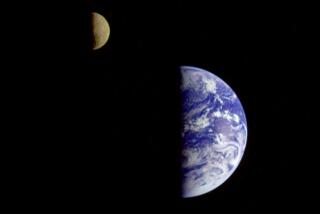New Technique Allows Astronomers to View Moonlet Orbiting Asteroid
- Share via
Astronomers have for the first time observed a moonlet orbiting an asteroid using ground-based telescopes. The Galileo probe photographed a small moon now called Dactyl orbiting (243)Ida on a 1993 flyby, but blurring caused by the Earth’s atmosphere has previously made it impossible to view such small objects. The image above, captured on five nights to show the orbit of the moonlet, was made with the Canada-France-Hawaii Telescope, which uses a new technique called adaptive optics to reduce blurring.
A team from the Southwest Research Institute reports in today’s Nature that the 8-mile-wide satellite, as yet unnamed, orbits (45)Eugenia every 4.7 days at a distance of 738 miles. The orbital characteristics indicate that (45)Eugenia is either a pile of rubble or composed mostly of ice. Further information is available at https://www.boulder.swri.edu/~merline/press_release/
Compiled by Times medical writer Thomas H. Maugh II





